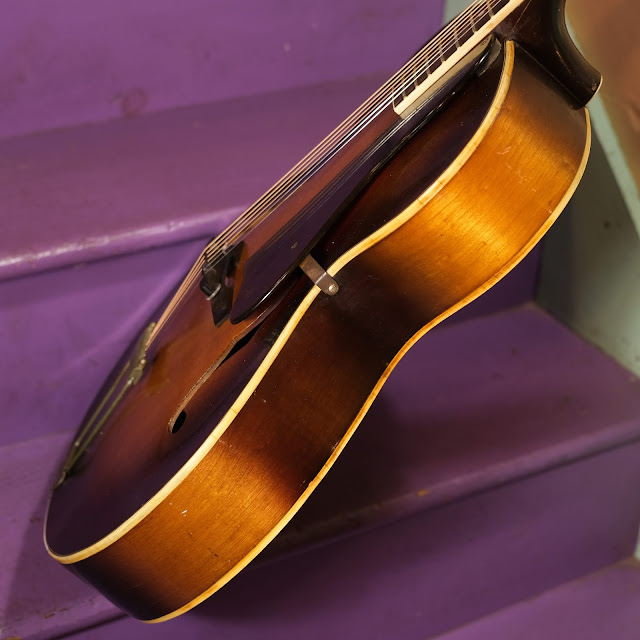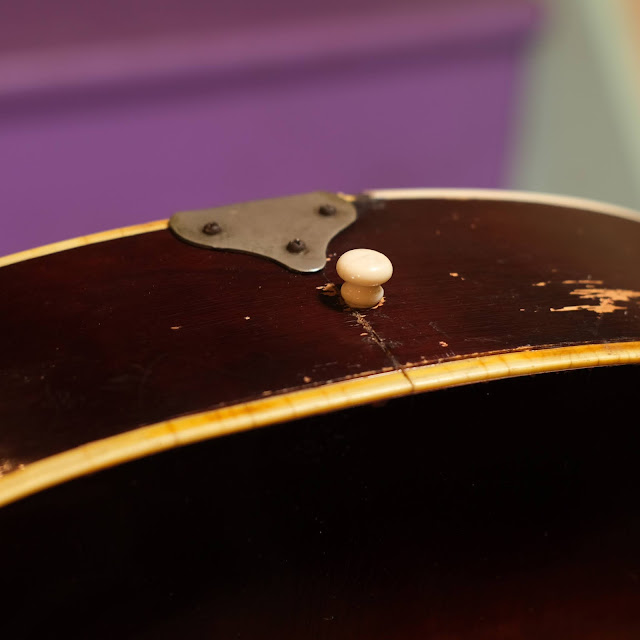1950s Unmarked Mystery 17" Archtop Guitar
This is the most confusing archtop I've had through the shop in a while. It's unmarked but shares features from a variety of makers from the time (we're talking late '40s, early '50s). It came in a period Epiphone case with the E on the inside and has an Epiphone-like 25 1/2" scale length, 1 5/8" nut width, and a fretboard extension mated to the normal part of the neck on a diagonal joint (that's very Epi).
Everything else is very much not Epiphone, though. The heel shape is wrong, the back of the neck is a medium-bigger full C, the body shape is vaguely like a Gibson 17" archtop but has Kalamazoo-like f-holes and shoulders that "slope down" in more of an Epi-style fashion, there is no truss rod in the neck, and the body is ply-all-over in construction. The top has two layers of spruce backed by birch while the back and sides are figured maple backed with birch.
Two other companies come to mind, though, when examining it. Its body style and construction remind me a lot of '50s Guild acoustic archtops and the body shape is even pretty close to the lines of the 16" archtops made by Guild that I've handled (take a close look at them and examine the shoulders, body outline, and headstock shape). However, I think more of the details resolve themselves as suggesting that this guitar was made by United in New Jersey. It has the headstock "stinger" of black paint on the back, flatter fretboard radius, correct heel shape, correct neck-shape, and binding style I expect from that maker. The lack of a truss rod and the smaller headstock shape are what make me leery of calling it a United "for sure," but the ply style for the top (2 thicker layers of spruce backed with thin birch) seems really close to United builds. I haven't handled a United with a 25 1/2" scale yet, though, as most have 25" across their production.
All that said -- it's a great guitar. It's loud, raucous, punchy, full in the mids and lower-mids, has lots of snap and zip in the high-end, and handles nicely. The neck is straight and "big" but comfortable... and it has larger-than-average frets for the time, which feel generous compared to something like a period Gibson. It also looks cool with its almost-Gibson body shape that's tweaked in the shoulders. It makes an excellent jazz-style chord-chopper and has the ability to slap some lead-work down, too.
Repairs included: fret level dress, replacement bridge, cleaning, setup.
Made by: possibly United
Made in: USA, probably New Jersey
Top wood: ply spruce
Back & sides wood: ply flamed maple
Bracing type: tonebar (asymmetrical -- bass-side straight, treble-side angled)
Bridge: rosewood
Fretboard: rosewood
Neck wood: maple
Tone: chunky, woody, full, punchy, projects well, saucy lower-mids/mids
Action height at 12th fret: 3/32” bass 1/16” treble (fast, spot-on)
String gauges: 54w-12 lights
Neck shape: medium-big C
Board radius: ~14"
Truss rod: non-adjustable but must have a steel rod in there
Neck relief: straight
Fret style: medium-bigger
Scale length: 25 1/2"
Nut width: 1 5/8"
Body length: 20 1/2"
Body width: 17 1/8"
Body depth: 3 1/4"
Weight: 5 lb 2 oz
Condition notes: it's worn and played throughout but has a nice, vintage, "glow" to it. The neck was reset previously at a good angle but I did have to clean-up a messy reglue job at the joint. It's stable. The bridge is a new replacement, the endpin is an older replacement, and the tuners might be newer than the guitar but are older Klusons. I had to move the tailpiece over a little as it was not aligned with the neck or centerline of the guitar as-installed. The binding on the body has rotted a bit and has lots of little cracks throughout. There's a replacement section of binding about 4" long near the tailpiece on the top edge. The nut is worn but repaired/works well.
It comes with: a 1940s/1950s Epiphone 17" jumbo hard case.





















Comments
Two years ago I found a 1925-ish 17" Jumbo dreadnought style acoustic guitar. It had been in a Texas Attic for decades unused and falling apart and unless. Most of the glue had melted long ago. I bought the guitar for $10 and put it together. There is no documentation written inside this guitar either.
It took me the better part of a year to reassemble the guitar. Months of the work was just bending the wood back into the right shape with moister and an assortment of clamps. I really did not need a fifth 6 string guitar so about 6 months ago I took off the neck, moved the sound hole down over an inch and put a baritone neck on the body. The tone board was terrible so I took the sound board to a furniture factory and hcd the top and bottom of the tone board sanded in hald. Sanding both faces. I took new sound board and had it sended in half and glued both of them to replace the sound board with a new one exactly the same size of the original. The top is the old wood (looking new!) and the inside is new.
When I replaced the braces I did not copy the original plans, I copied what the New Martins are using in the 2023 models guitars. It uses shorter braces and more of them drawing the sounds directly to the sound hole from all direction on the inside. A luthier friend of mine taught me that.
I am at the place to finish up the Sunburst and put the strings on. I am partly blind and it takes me a while longer to do the work. But at age 79 I am not ever bored anymore. I will send you a photo if you send me an email so I can. I just noticed the Comments warning just below this block. opps! My shorter email is Lee@Fba.cc